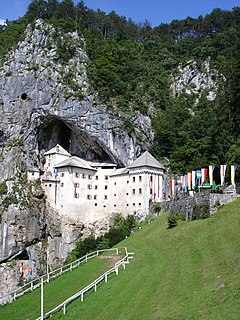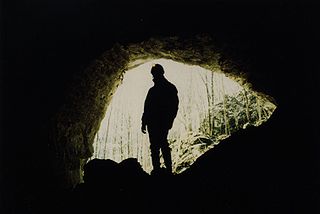 W
WA cave or cavern is a natural void in the ground, specifically a space large enough for a human to enter. Caves often form by the weathering of rock and often extend deep underground. The word cave can also refer to much smaller openings such as sea caves, rock shelters, and grottos, though strictly speaking a cave is exogene, meaning it is deeper than its opening is wide, and a rock shelter is endogene.
 W
WThis List of longest caves includes caves in which the combined length of documented passageways exceeds 200 km. In some of these caves, passageways are still being discovered.
 W
WA subterranean river is a river that runs wholly or partly beneath the ground surface – one where the riverbed does not represent the surface of the Earth. It is distinct from an aquifer, which may flow like a river but is contained within a permeable layer of rock or other unconsolidated materials. A river flowing below ground level in an open gorge is not classed as subterranean.
 W
WAtlantida is a karst cave in Ukraine, most famous for its unusual geology, rare formations, and pristine condition. It is located at the bank of the river Zbruch in Kamianets-Podilskyi Raion of the Khmelnytskyi Oblast, close to Zavallya village. The cave is 2525 m long and 18 m deep, with 4440 m² area. Subordinated to the Tourism and Excursions Council of Khmelnytskyi Oblast, the cave is a part of the Podilski Tovtry National Nature Park.
 W
WA cave castle or grotto castle is a residential or refuge castle that has been built into a natural cave. It falls within the category of hill castles. Unlike other types, such castles can only be assaulted from the front, or by drilling through the rock above; the gateway is usually located in the middle of a rock face, which makes it much more difficult to penetrate. Archaeological discoveries have revealed that caves were used as places of refuge as early as the Stone Age. The first medieval cave castles emerged in the 11th and 12th centuries. In the 14th and 15th centuries this type became more widespread, especially in certain parts of France and Switzerland.
 W
WA cave gate is a manmade barricade typically placed at the entrance to a cave or just inside the entrance of a cave in an effort to impede or mitigate human access to a cave's interior. The reason for gating a cave can be varied, but may include protecting sensitive or endangered bat species, protecting fragile cave resources, or restricting access to dangerous caves.
 W
WA cave pearl is a small, usually spherical, speleothem found in limestone caves. Cave pearls are formed by a concretion of calcium salts that form concentric layers around a nucleus. Exposure to moving water polishes the surface of cave pearls, making them glossy; if exposed to the air, cave pearls can degrade and appear rough.
 W
WA cave-in is a collapse of a geologic formation, mine or structure which may occur during mining or tunneling. Geologic structures prone to spontaneous cave-ins include alvar, tsingy and other limestone formations, but can also include lava tubes and a variety of other subsurface rock formations. Glacier caves and other ice formations are very prone to collapse from exposure to warm temperatures or running water.
 W
WA cave dweller, or troglodyte, is a human being who inhabits a cave or the area beneath the overhanging rocks of a cliff.
 W
WA glacier cave is a cave formed within the ice of a glacier. Glacier caves are often called ice caves, but the latter term is properly used to describe bedrock caves that contain year-round ice.
 W
WThe Hospital in the Rock Nuclear Bunker Museum is the name given to a hospital created in the caverns under Buda Castle in Budapest in the 1930s, in preparation for the Second World War.
 W
WA solutional cave or karst cave is a cave usually formed in the soluble rock limestone. It is the most frequently occurring type of cave. It can also form in other rocks, including chalk, dolomite, marble, salt beds, and gypsum.
 W
WThe following is a list of the longest caves in the United States per length of documented passageways. Many passageways are still being discovered; this list is based on the latest verifiable data.
 W
WA pit cave, shaft cave or vertical cave—or often simply called a pit or pot ; jama in South Slavic languages scientific and colloquial vocabulary —is a type of cave which contains one or more significant vertical shafts rather than being predominantly a conventional horizontal cave passage. Pit caves typically form in limestone as a result of long-term erosion by water. They can be open to the surface or found deep within horizontal caves. Among cavers, a pit is a vertical drop of any depth that cannot be negotiated safely without the use of ropes or ladders.
 W
WA rock shelter is a shallow cave-like opening at the base of a bluff or cliff. In contrast to solutional caves (karst), which are often many miles long, rock shelters are almost always modest in size and extent.
 W
WA solutional cave or karst cave is a cave usually formed in the soluble rock limestone. It is the most frequently occurring type of cave. It can also form in other rocks, including chalk, dolomite, marble, salt beds, and gypsum.
 W
WSpeleology is the scientific study of caves and other karst features, as well as their make-up, structure, physical properties, history, life forms, and the processes by which they form (speleogenesis) and change over time (speleomorphology). The term speleology is also sometimes applied to the recreational activity of exploring caves, but this is more properly known as caving, potholing, or spelunking. Speleology and caving are often connected, as the physical skills required for in situ study are the same.
 W
WA subterranean waterfall or underground waterfall is a waterfall located underground, usually in a cave or mine. They are a common feature in cave systems where there are vertical or near vertical geological structures for the weathering process to exploit, and sufficient gradient between the sink and the rising. The highest known subterranean waterfall is in Vrtoglavica Cave in Slovenia, and is at least 400 metres (1,300 ft). A renowned example in the United States is Ruby Falls, 44 metres (144 ft) high, in Lookout Mountain Caverns, a show cave in Tennessee.
 W
W‘’’Sukhanand Dham’’’ or Sukhanand ji is located at a distance of about 10 km (6.2 mi) from the city of Jawad, which is more of an ancient rock-cave that is located on the border of the Rajasthan State. This ashram is said to be built by the son of Vedavyasa, known by the name of Suka, Sukadev, Sri Suka and Brahmarata. This ashram also consists of a temple dedicated to Lord Shiva and it is wholly surrounded by the mountains and a waterfall and Sukhanand Sagar Dam nearby.
 W
WMysterious tunnels or "secret passages" are a common element of the local folklore tradition in Europe. In Norwegian a secret tunnel-like passage is called a lønngang and in Swedish a lönngång. Such tunnels are said to physically link prominent places such as country houses, castles, churches, ancient monuments and other, often medieval, buildings.
 W
WAn underground lake or subterranean lake is a lake under the surface of the Earth. Such lakes may be associated with caves, aquifers, or springs. They are typically very low in salinity.